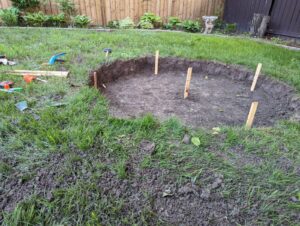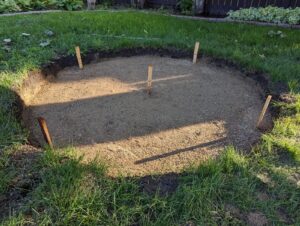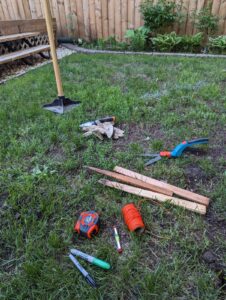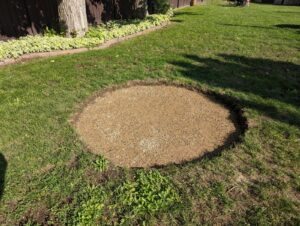Now that my body has slightly recovered from digging the firepit area, I have moved onto creating the base layer, which involves the repetitive task of leveling the gravel: one wheelbarrow-full at a time. In the evenings (when it hasn’t been raining), I’ve spent several hours in what feels like an infinite loop of moving gravel (also known as ‘crusher dust’):
shoveling, dumping, raking, leveling, and tamping…
shoveling, dumping, raking, leveling, and tamping…
shoveling, dumping, raking, leveling, and tamping.
This layer of crusher dust serves as the base layer for the paving stone firepit area. Since the planning of the project is in the past, I am now into the stages of actual seeing things come together. This is such a satisfying feeling, and at the same time, it has allowed me to reflect on how beneficial (or unhelpful) the online resources I have accessed actually are.
One of the resources that I have frequently referred to throughout this project is the YouTube video Fire Pit Patio Build – DIY Project by Bro Builds. Here are my critiques on this resource thus far:
Pros:
- They provide a very honest account of what goes into a project like this (for example, there’s a lot of digging and manual labour involved).
- Throughout the video, they provided ‘Bro Tips’, which are tips and tricks that would help anyone who’s planning to do their own DIY fire pit patio build.
- They discussed what mistakes they made and provided advice of what they would change if they could do the project all over again.
- The final layout of the project (a circular fire pit patio area made of paving stones) was quite similar to the idea I had in mind, so I have been able to (and plan to continue to) follow the steps in the video through to the end of the project.
Cons:
- Appears to be the first time they’ve done a project like this. They definitely weren’t experts in this area!
- Countless errors or mistakes were made along the way, so you couldn’t just watch the video and learn from it that way. Their commentary was crucial in providing advice or suggestions of what they would’ve done differently.
- Didn’t provide advice about where to get the circular-shaped paving stone kit, specifically the wedge/pie shaped patio stones. I will discuss this in one of my future posts, but I ended up going to 4-5 different stores before realizing that paving stones needed to make a circular shape had to be ordered in a special kit. More on that later!
The 10-Step Guide to Installing Pavers pdf guide has been another resource I have often accessed throughout my project. The positives and negatives of this resource are:
Pros:
- Short, sweet, and to the point. The step-by-step instructions are not overly wordy, but still provide enough detail for someone familiar with the end-goal of the project to be able to ‘do it right’ the first time.
- Pictures that are included in the guide helped to visualize each step. Any equipment that is required for each step is included in the pictures/descriptions, as well.
- A one-page (double-sided) guide was great to have on hand while working outside. I was often dirty, working in the sun, and had to refer to the instructions often. Having a one-page guide (I printed it out) was useful so that I didn’t need to have my laptop or phone outside with me.
Cons:
- A minimal amount of detail. The guide assumes that there is a solid base knowledge in place and doesn’t overly elaborate on the specifics of each step.
- Difficult to visualize what each step looks like while performing each step/task. The pictures mostly show the ‘end result’ of each step.
Here are some pictures that I took tonight as I approach the end of creating the base layer. I still need probably 4-6 pails (5-gallon pails) worth of crusher dust (15 pails of crusher dust have already been used). Up next is finishing off the base layer and then creating the 1” sand bedding layer. After that, the fun part begins: laying down the actual paving stones!

Hole before starting to lay the base layer.

The base layer, nearly complete.

Some of the tools used to create the base layer.
Update (as of June 11, 2023):
The base layer of crusher dust is now complete! Tamped and leveled, 3″ below the surface of the grass. This will allow for 1″ of sand and 2 3/8″ paver stones to be added. Paving stones are ordered and should be delivered this upcoming Friday. Hoping to install those next weekend. Almost there!

Base layer of gravel is now complete.

Base layer of gravel is now complete.

Hi Mike, I am actually really excited about your learning project and once this class is completed and I am done my project I plan on coming back to yours simply because we are landscaping our place at the lake this year. My husband just built the deck to our camper and one of our tasks will be installing some pavers on the lower level. Cannot wait to learn from your learning!
Hey Christine! That’s awesome that you and your husband are also doing some deck building and paving stone installation at your lake. Sounds very exciting! Hopefully something I’m learning and posting about can be of assistance to you. DIY projects are fun to take on, but can become quite busy and time-consuming. Having the finish line in sight is definitely keeping me motivated!
Do you spend a good part of your summer at the lake?
Mike, I love how your project is coming along! There are a few projects I am following and yours is one of them! 🙂 I am so excited to see the finished project. I hope you post a pic of yourself, relaxing with a nice cold drink of choice! I am wanting to put in a firepit in our backyard, but at this point, I am opting for a propane fire table instead. LOL I definitely do not have the skills or motivation to take on a project like this. Best of luck with your project.